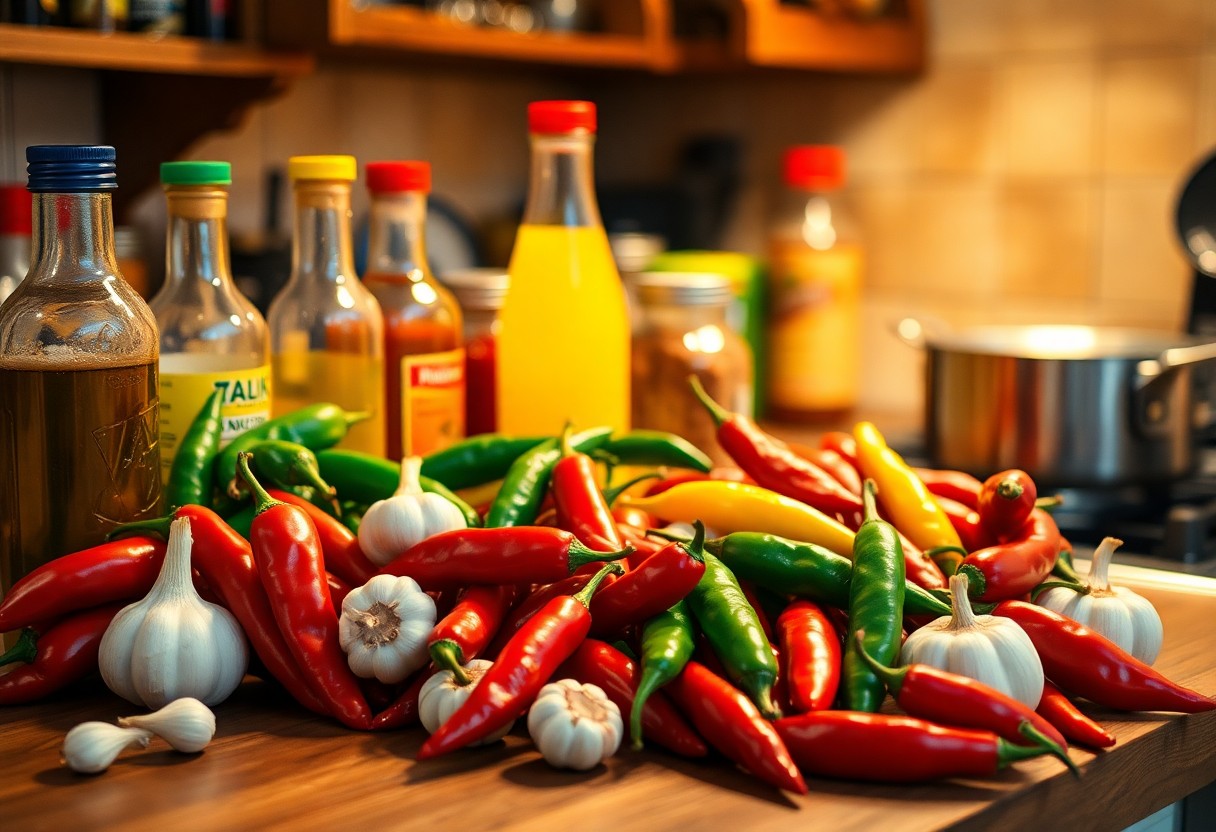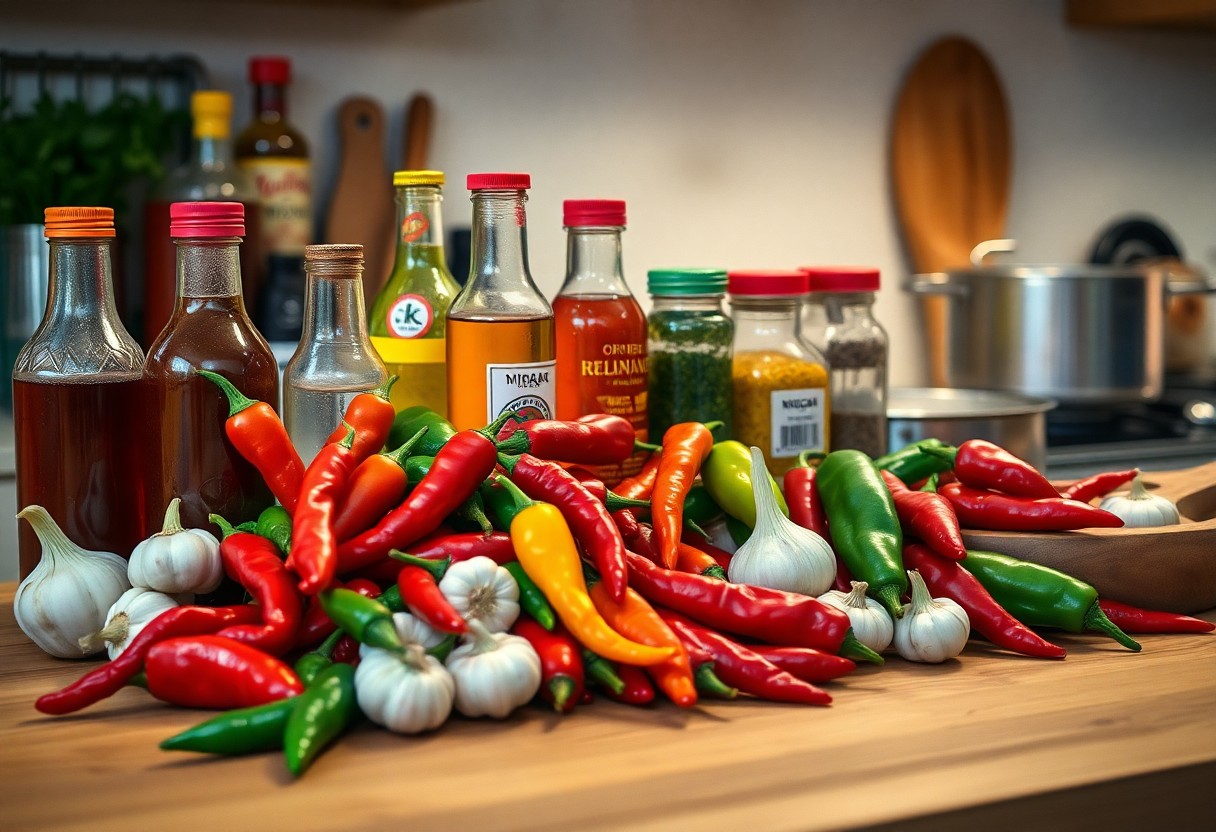How Do You Make Hot Sauce at Home?
Blazing with flavor and perfectly customizable, homemade hot sauce lets you create your ideal balance of heat and taste. If you’ve ever wanted to craft your own signature sauce, you’ll be pleased to know that making hot sauce at home is simpler than you might think. With just a few basic ingredients and some imperative kitchen tools, you can whip up a batch that rivals your favorite store-bought brands. Whether you prefer a mild kick or an intense burn, mastering your own hot sauce recipe gives you complete control over the heat level and flavor profile.
Understanding Hot Sauce
While hot sauce making might seem intimidating, it’s actually a straightforward process that combines fresh ingredients with time-tested techniques. You’ll discover that crafting your own sauce allows you to control heat levels, customize flavors, and create unique combinations that match your taste preferences.
Key Ingredients
Little do most people know that quality hot sauce requires just a few basic components. You’ll need fresh peppers as your base, vinegar for preservation and tang, salt for flavor enhancement, and optional ingredients like garlic, onions, or fruits for depth. Your choice of ingredients will determine the final character of your sauce.
Types of Peppers
With so many pepper varieties available, you can create countless unique hot sauce combinations. Here’s a guide to help you choose:
- Jalapeños for mild, bright heat
- Habaneros for intense, fruity spice
- Ghost peppers for extreme heat
- Scotch bonnets for Caribbean flair
- Though cayenne peppers remain the most versatile choice for beginners
| Pepper Type | Heat Level (Scoville) |
|---|---|
| Jalapeño | 2,500-8,000 |
| Habanero | 100,000-350,000 |
| Ghost Pepper | 855,000-1,041,427 |
| Scotch Bonnet | 100,000-350,000 |
| Cayenne | 30,000-50,000 |
How-to Make Hot Sauce
You can create delicious hot sauce at home with just a few ingredients and basic equipment. Your kitchen will transform into a hot sauce laboratory where you’ll combine chilies, vinegar, salt, and aromatics to craft your signature blend. The process offers two main approaches: quick-cooking method or fermentation, each bringing unique flavors to your final product.
Basic Recipe Steps
Little preparation goes into making a basic hot sauce. First, you’ll need to clean and chop your chosen peppers. Mix them with vinegar, salt, and any additional ingredients like garlic or onions in a saucepan. Simmer the mixture for 15-20 minutes, let it cool, then blend until smooth. Strain if you prefer a thinner consistency, and bottle your creation.
Fermentation Process
Howto ferment your hot sauce starts with submerging chopped peppers and aromatics in a salt brine solution. You’ll need to keep the mixture in an airtight container at room temperature for 5-7 days, checking daily for bubbles and development of tangy flavors.
To achieve the best fermentation results, maintain a 2-3% salt ratio to water, and ensure all ingredients stay submerged beneath the brine. Your fermentation vessel should be placed in a dark spot at around 70°F. After fermentation, blend the peppers with some of the brine, strain if desired, and bottle. You can adjust the thickness by adding vinegar or more brine.
Tips for Flavor Enhancement
Some of the most impactful flavor enhancements come from simple techniques you can easily implement. Roasting your peppers and garlic before blending intensifies their natural sweetness, while fermenting your ingredients adds complexity and depth. Adding a splash of vinegar brightens the overall taste, and incorporating fresh herbs like cilantro or oregano brings aromatic dimensions to your sauce. After achieving your desired base flavor, let your hot sauce rest for 24 hours to allow the flavors to meld together perfectly.
Balancing Heat and Flavor
Heat should never overpower the overall taste experience of your hot sauce. You can control the spiciness by adjusting the ratio of peppers to other ingredients, and by removing seeds and membranes for a milder result. Consider combining different pepper varieties to create a more complex heat profile – pair habaneros with jalapeños or ghost peppers with sweet bell peppers. Adding fruits like mango or pineapple helps balance the heat while introducing natural sweetness.
Additives and Variations
Balancing your hot sauce with complementary ingredients opens up endless possibilities for unique flavor profiles. You can experiment with carrots for natural sweetness, ginger for warmth, or lime juice for brightness. Adding spices like cumin, coriander, or smoked paprika brings depth, while a touch of honey or brown sugar rounds out sharp edges.
With the right additives, you can create signature variations that match specific cuisines or dishes. Try adding sesame oil and rice vinegar for an Asian-inspired sauce, or combine chipotle and Mexican oregano for a Latin twist. Fruit-based additions like mango, peach, or pineapple create tropical variations, while roasted garlic and herbs steer toward Mediterranean flavors.
Factors Affecting Hot Sauce Quality
Despite your best efforts in following recipes, several factors can influence your hot sauce’s final quality. The outcome depends on:
- Ingredient freshness and ripeness
- Processing methods and temperature control
- pH levels and preservation techniques
- Storage conditions and container selection
- Fermentation duration and environment
Knowing these elements helps you maintain consistency and achieve your desired flavor profile.
Ingredient Freshness
Assuming you’ve gathered all your ingredients, their freshness will significantly impact your hot sauce’s flavor and heat level. Fresh peppers provide brighter flavors and more consistent heat, while fresh garlic and herbs contribute cleaner, more pronounced notes. You’ll notice that properly ripened peppers offer better color and natural sweetness, enhancing your sauce’s overall profile.
Storage and Shelf Life
Life of your homemade hot sauce largely depends on how you store it. You’ll get the best results by keeping your sauce in sterilized, airtight glass containers away from direct sunlight. Your sauce can last 3-6 months in the refrigerator when properly prepared and stored.
Another factor that extends your hot sauce’s shelf life is the acidity level. You can increase longevity by maintaining a pH below 4.0 through proper vinegar ratios. Your storage containers should be dark-colored glass bottles to protect against light exposure, and always keep the cap tightly sealed between uses to prevent contamination.
Customizing Your Hot Sauce
Not all hot sauces need to follow traditional recipes. You can create your own signature blend by adjusting ingredients and ratios to match your taste preferences. Whether you prefer fruity, smoky, or tangy flavors, the possibilities are endless when you experiment with different peppers, aromatics, and seasonings.
Creating Unique Blends
For a truly personal hot sauce, you can mix and match complementary ingredients. Try combining mangoes with habaneros, roasted garlic with chipotle peppers, or pineapple with scotch bonnets. Your creativity in pairing fruits, herbs, and spices will help you develop distinctive flavors that set your sauce apart.
Experimenting with Heat Levels
Some peppers pack more punch than others, so you can adjust your hot sauce’s intensity by selecting different chilies. You might start with milder jalapeños before working your way up to ghost peppers or Carolina Reapers. The seeds and membranes contain most of the heat, so removing them helps control the spiciness.
Plus, you can fine-tune your hot sauce’s heat level by blending different peppers together. A combination of mild and hot peppers allows you to create balanced heat while maintaining complex flavors. Testing small batches helps you perfect your ideal spice level without wasting ingredients.
Common Mistakes to Avoid
All hot sauce making endeavors can face setbacks, but knowing the common pitfalls will help you create better results. From improper ingredient ratios to rushing the fermentation process, these mistakes can affect both the flavor and safety of your final product. Taking time to understand these potential issues will enhance your hot sauce-making skills and lead to consistently excellent results.
Overlooking Safety Precautions
Avoid handling hot peppers without proper protection. Always wear gloves when cutting and processing peppers, and ensure proper ventilation in your workspace. The oils from hot peppers can cause severe irritation to your skin and eyes, while the fumes during cooking can affect your breathing. Keep vinegar and milk nearby to neutralize capsaicin burns, and never touch your face while working with hot peppers.
Skipping Taste Testing
You need to taste your hot sauce throughout the cooking process to achieve the perfect balance of heat and flavor. Start with small samples and adjust seasonings gradually to control the heat level and overall taste profile.
Another important aspect of taste testing is allowing your palate to reset between samples. Keep plain bread, milk, or yogurt nearby to cleanse your taste buds. This helps you make more accurate adjustments to your recipe and prevents flavor fatigue during the testing process.
Final Words
Taking this into account, making hot sauce at home gives you complete control over heat levels, flavor profiles, and ingredient quality. Your homemade creation can be customized to match your exact taste preferences, from mild and tangy to intensely spicy. By following proper sanitization methods and storage practices, you can enjoy your signature hot sauce for several months. Whether you choose fermentation or direct cooking methods, the satisfaction of crafting your own condiment makes the process worthwhile. Now you’re ready to start your hot sauce-making journey with confidence.









